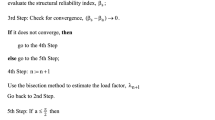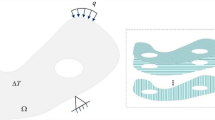Abstract
Uncertainties in deviations of physical properties lead to a probabilistic failure analysis of the composite materials. The proposed optimization model for laminate composites is based on reliability analysis considering the ultimate failure state. To avoid difficulties associated with the complete analysis of the failure modes, bounds are established for the failure probability of the structural system. These bounds are related with theintact and degraded configurations of the structure. Using thefirst ply failure and thelast ply failure theories and a degradation model for the mechanical properties with load sharing rules we obtain the failure probabilities corresponding to the two above configurations. The failure probability of each configuration is obtained using level 2 reliability analysis and the Lind-Hasofer method.
The optimization algorithm is developed based on the problem decomposition into three subproblems having as objectives the maximization of the structural efficiency atintact and degraded configurations of the structure and weight minimization subjected to allowable values for the structural reliability. Additionally, the search for the initial design is performed introducing a weight minimization level. It is expected to explore the remaining load capacity of the structures afterfirst ply failure as a function of the anisotropic properties of the composites. The design variables are the ply angles and the thicknesses of the laminates. The structural analysis for the model developed is performed through the finite element method mainly using the isoparametric degenerated shell finite element. The sensitivities are obtained using the discrete approach through the adjoint variable method. In order to show the performance of the analysis two examples are presented.
Similar content being viewed by others
References
Ahmad, S. 1969:Curved finite elements in the analysis of solid, shell and plate structures. Ph.D. Thesis, University College of Swansea
Arora, J.S. 1989:Introduction to optimum design. New York: McGraw Hill
Arora, J.S.; Chahande, A.I.; Paeng, J.K. 1991: Multiplier methods for engineering optimization.Int. J. Num. Meth. Engng. 32, 1485–1525
Borri, A.; Speranzini, E.; Venturini, R. 1993: Reliability based multicriteria optimal design: an application to composite material structures. In: Herskovits, J. (ed.)Structural optimization, pp. 449–456. Rio de Janeiro: Universidade Federal do Rio de Janeiro
Conceição António, C.A. 1995:Optimization of structures using composite materials made of polimeric matrix (in Portuguese). Ph. D. Thesis, Universidade do Porto, Portugal
Conceição António, C.A.; Torres Marques, A.; Soeiro, A.V. 1993: Influence of physical properties randomness in laminated composites strength.Proc. ICCM-9, pp. 185–192. Madrid, Spain: University of Zaragoza & Woodhead Publishing Ltd
Hasofer, A.M.; Lind, N.C. 1974: Exact and invariant secondmoment code format.ASCE J. Eng. Mech. Div. 100, 111–121
Kirsch, U. 1982:Optimum structural design. New York: McGraw Hill
Lind, N.C. 1974: A formulation of probabilistic design.Report 128, Solid Mechanics Division, University of Waterloo
Ling, Y.; Zukang, M. 1987: Optimum design based on reliability for composite laminates. In: Marshall, I.H. (ed.)Composite structures, pp. 1378–1392. New York: Elsevier Applied Science
Maekawa, Z.; Hamada, H.; Horino, T.; Nakayasu, H. 1988: Probabilistic design of fibre-reinforced polymers using first-order second-moment method. In: Paipetis, S.A.; Papanicolau, G.C. (eds.)Engineering applications of new composites, pp. 153–161. Wallingford (UK): Omega Scientific
Polak, E. 1971:Computational methods in optimization. New York: Academic Press
Rao, S.S. 1992:Reliability-based design. New York: McGraw Hill
Renard, J.; Favre, J.P.; Jeggy, T. 1992: Influence of transverse cracking on ply behaviour: introduction of a characteristic damage variable.Composites Sci. & Tech. 46, 29–37
Soeiro, A.V.; Conceição António, C.A.; Torres Marques, A. 1994: Multilevel optimization of laminated composite structures.Struct. Optim. 7, 55–60
Talreja, R. 1985: Transverse cracking and stiffness reduction in composite laminates.J. Comp. Mat. 19, 355–375
Tsai, S.W. 1987:Composites design. Dayton, USA: Think Composites
Tsai, S.W.; Hahn, H.T. 1980:Introduction to composite materials. Westport, Connecticut: Technomic Publishing Co.
Vanderplaats, G.N. 1984:Multiplier optimization techniques for engineering design with applications. New York: McGraw Hill
Author information
Authors and Affiliations
Rights and permissions
About this article
Cite this article
António, C.A.C., Marques, A.T. & Gonçalves, J.F. Reliability based design with a degradation model of laminated composite structures. Structural Optimization 12, 16–28 (1996). https://doi.org/10.1007/BF01270440
Received:
Issue Date:
DOI: https://doi.org/10.1007/BF01270440




